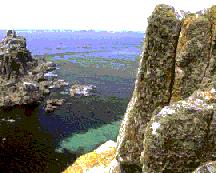- Language Description
- Celtic Links
 The
language belonged to the people who lived on the peninsula, Celtic, spoken
by the original Britons. Their portion of what was later thought
of as England was independent even in Anglo-Saxon times and though a substantial
number of migrants from the peninsula were to resettle across the English
channel in Brittany, its population remained Celtic. In the 11th
century Cornwall, the name of their homeland, was conquered by Normans,
following which the Cornish people slowly began to languish together with
their language, more and more widely replaced by English: the peninsula
is not a physical region isolated by mountains such as Scotland and Wales,
and inevitably the the tongue was unable to defend itself against the massive
tide of Anglo-Norman speech encroachment. In the 18th century the
last remaining speakers of Cornish disappeared*, leaving behind, however,
its rich literature dating back to the 15th century and represented mainly
by poetry -- there are yet a lot of verses from the 16th and
17th centuries written in Cornish.
The
language belonged to the people who lived on the peninsula, Celtic, spoken
by the original Britons. Their portion of what was later thought
of as England was independent even in Anglo-Saxon times and though a substantial
number of migrants from the peninsula were to resettle across the English
channel in Brittany, its population remained Celtic. In the 11th
century Cornwall, the name of their homeland, was conquered by Normans,
following which the Cornish people slowly began to languish together with
their language, more and more widely replaced by English: the peninsula
is not a physical region isolated by mountains such as Scotland and Wales,
and inevitably the the tongue was unable to defend itself against the massive
tide of Anglo-Norman speech encroachment. In the 18th century the
last remaining speakers of Cornish disappeared*, leaving behind, however,
its rich literature dating back to the 15th century and represented mainly
by poetry -- there are yet a lot of verses from the 16th and
17th centuries written in Cornish.
The language is closely related to Breton, less so to Welsh, Gaelic
and Manx. Nowadays linguistic societies divide the tongue into three
main versions or dialects called Kemmyn, Unified and Modern. Of them,
Modern is based on the Middle and Old Cornish lexicon and grammar while
Kemmyn and Unified are very much the same, spelling their only difference.
But the structure, the unique Celtic morphological structure, remains the
same everywhere. Cornish also has prepositional pronouns, initial
mutations and verb-based syntax.